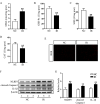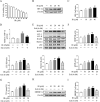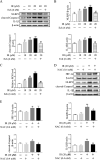Contribution of HIF-1α/BNIP3-mediated autophagy to lipid accumulation during irinotecan-induced liver injury
- PMID: 37085612
- PMCID: PMC10121580
- DOI: 10.1038/s41598-023-33848-y
Contribution of HIF-1α/BNIP3-mediated autophagy to lipid accumulation during irinotecan-induced liver injury
Abstract
Irinotecan is a topoisomerase I inhibitor which has been widely used to combat several solid tumors, whereas irinotecan therapy can induce liver injury. Liver injury generally leads to tissue hypoxia, and hypoxia-inducible factor-1α (HIF-1α), a pivotal transcription factor, mediates adaptive pathophysiological responses to lower oxygen condition. Previous studies have reported a relationship between HIF-1α and autophagy, and autophagy impairment is a common characteristic in a variety of diseases. Here, irinotecan (50 mg/kg) was employed on mice, and HepG2 and L-02 cells were cultured with irinotecan (10, 20 and 40 μM). In vivo study, we found that irinotecan treatment increased final liver index, serum aminotransferase level and hepatic lipid accumulation. Impaired autophagic flux and activation of HIF-1α/BNIP3 pathway were also demonstrated in the liver of irinotecan-treated mice. Moreover, irinotecan treatment significantly deteriorated hepatic oxidative stress, evidenced by increased MDA and ROS contents, as well as decreased GSH-Px, SOD and CAT contents. Interestingly, protein levels of NLRP3, cleaved-caspase 1 and IL-1β were enhanced in the liver of mice injected with irinotecan. In vitro study, irinotecan-treated HepG2 and L-02 cells also showed impaired autophagic flux, while HIF-1α inhibition efficaciously removed the accumulated autophagosomes induced by irinotecan. Additionally, irinotecan treatment aggravated lipid accumulation in HepG2 and L-02 cells, and HIF-1α inhibition reversed the effect of irinotecan. Furthermore, HIF-1α inhibition weakened irinotecan-induced NLRP3 inflammasome activation in HepG2 cells. Taken together, our results suggest that irinotecan induces liver injury by orchestrating autophagy via HIF-1α/BNIP3 pathway, and HIF-1α inhibition could alleviate irinotecan-induced lipid accumulation in HepG2 and L-02 cells, which will provide a new clue and direction for the prevention of side effects of clinical chemotherapy drugs.
© 2023. The Author(s).
Conflict of interest statement
The authors declare no competing interests.
Figures







Similar articles
-
HIF-1α/BNIP3-Mediated Endoplasmic Reticulum Degradation via Autophagy Protects Against Ischemia Reperfusion-Induced Acute Kidney Injury.Antioxid Redox Signal. 2025 Feb;42(4-6):212-227. doi: 10.1089/ars.2023.0467. Epub 2024 Aug 28. Antioxid Redox Signal. 2025. PMID: 39099334
-
The role of HIF-1α/BNIP3/mitophagy in acrylonitrile-induced neuronal death in HT22 cells and mice: A potential neuroprotection target.Chem Biol Interact. 2025 Jan 25;406:111327. doi: 10.1016/j.cbi.2024.111327. Epub 2024 Nov 29. Chem Biol Interact. 2025. PMID: 39615733
-
HIF-1α/BNIP3 signaling pathway-induced-autophagy plays protective role during myocardial ischemia-reperfusion injury.Biomed Pharmacother. 2019 Dec;120:109464. doi: 10.1016/j.biopha.2019.109464. Epub 2019 Oct 4. Biomed Pharmacother. 2019. PMID: 31590128
-
The role of hypoxia-inducible factor 1α in hepatic lipid metabolism.J Mol Med (Berl). 2023 May;101(5):487-500. doi: 10.1007/s00109-023-02308-5. Epub 2023 Mar 28. J Mol Med (Berl). 2023. PMID: 36973503 Review.
-
Role of the HIF-1α/BNIP3 Signaling Pathway in Recurrent Hepatocellular Carcinoma and the Mechanism of Traditional Chinese Medicine.J Hepatocell Carcinoma. 2023 Jun 8;10:893-908. doi: 10.2147/JHC.S409292. eCollection 2023. J Hepatocell Carcinoma. 2023. PMID: 37313302 Free PMC article. Review.
Cited by
-
The Physiological Functions and Therapeutic Potential of Hypoxia-Inducible Factor-1α in Vascular Calcification.Biomolecules. 2024 Dec 12;14(12):1592. doi: 10.3390/biom14121592. Biomolecules. 2024. PMID: 39766299 Free PMC article. Review.
-
Therapeutic Effects and Molecular Mechanism of Chlorogenic Acid on Polycystic Ovarian Syndrome: Role of HIF-1alpha.Nutrients. 2023 Jun 21;15(13):2833. doi: 10.3390/nu15132833. Nutrients. 2023. PMID: 37447160 Free PMC article. Review.
-
Understanding Cancer's Defense against Topoisomerase-Active Drugs: A Comprehensive Review.Cancers (Basel). 2024 Feb 6;16(4):680. doi: 10.3390/cancers16040680. Cancers (Basel). 2024. PMID: 38398072 Free PMC article. Review.
References
Publication types
MeSH terms
Substances
LinkOut - more resources
Full Text Sources
Miscellaneous

